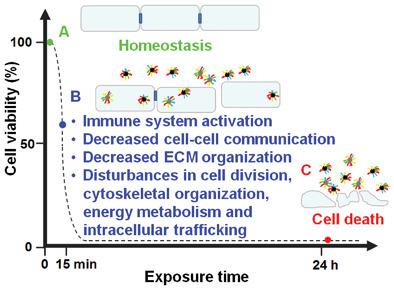当前位置:
X-MOL 学术
›
Part. Part. Syst. Charact.
›
论文详情
Our official English website, www.x-mol.net, welcomes your
feedback! (Note: you will need to create a separate account there.)
The Cytotoxicity of Metal Nanoparticles Depends on Their Synergistic Interactions
Particle & Particle Systems Characterization ( IF 2.7 ) Pub Date : 2020-07-06 , DOI: 10.1002/ppsc.202000135 Barbara Korzeniowska 1 , Micaella P. Fonseca 1 , Vladimir Gorshkov 1 , Lilian Skytte 2 , Kaare L. Rasmussen 2 , Henrik D. Schrøder 3 , Frank Kjeldsen 1
Particle & Particle Systems Characterization ( IF 2.7 ) Pub Date : 2020-07-06 , DOI: 10.1002/ppsc.202000135 Barbara Korzeniowska 1 , Micaella P. Fonseca 1 , Vladimir Gorshkov 1 , Lilian Skytte 2 , Kaare L. Rasmussen 2 , Henrik D. Schrøder 3 , Frank Kjeldsen 1
Affiliation

|
With a steady growth in use of engineered nanoparticles (NPs) in consumer products the unintended exposure to humans has increased. The risks associated with introduction of NPs in the environment have been widely investigated, but mostly for single type of NPs. Herein, a single NP and NP co‐exposure study is reported: the cellular effects of silver and platinum NPs on the main components of the blood–brain barrier, human cerebral microvascular endothelial cells, and human primary astrocytes. The synergy is quantitatively evaluated as per the Chou–Talalay method. NP co‐exposure synergistically inhibits proliferation of both cell types, to a greater extent for endothelial cells. In addition, astrocytes are more tolerant to NPs. The mechanism of synergy with short‐duration incubation time points (up to 30 min) is further explored. Although intracellular trafficking studies and quantitative assessments of NP uptake does not explain the mechanisms of synergistic cytotoxicity, a proteomics analysis suggests that it arises from activation of an immune modulating response and deregulation of the extracellular matrix organization. The substantial synergetic effects in the co‐exposure studies highlight the importance of this work in relation to assessment of the health risks associated with nanomaterials.
中文翻译:

金属纳米粒子的细胞毒性取决于它们的协同相互作用。
随着消费产品中工程纳米颗粒(NPs)的稳定使用,人们对人体的意外接触增加了。已广泛调查了与在环境中引入NP相关的风险,但大多数是针对单一类型的NP。本文报道了一项NP和NP共暴露研究:银和铂NP对血脑屏障,人脑微血管内皮细胞和人原代星形胶质细胞的主要成分的细胞作用。根据Chou-Talalay方法对协同作用进行了定量评估。NP共暴露协同抑制两种细胞的增殖,对内皮细胞有更大程度的抑制作用。另外,星形胶质细胞对NP更耐受。进一步探讨了与短时间孵育时间点(长达30分钟)协同作用的机制。尽管细胞内运输研究和NP摄入量的定量评估不能解释协同细胞毒性的机制,但是蛋白质组学分析表明,它是由于免疫调节反应的激活和细胞外基质组织的失调而引起的。共同暴露研究中的实质性协同效应凸显了这项工作在评估与纳米材料相关的健康风险方面的重要性。
更新日期:2020-07-06
中文翻译:

金属纳米粒子的细胞毒性取决于它们的协同相互作用。
随着消费产品中工程纳米颗粒(NPs)的稳定使用,人们对人体的意外接触增加了。已广泛调查了与在环境中引入NP相关的风险,但大多数是针对单一类型的NP。本文报道了一项NP和NP共暴露研究:银和铂NP对血脑屏障,人脑微血管内皮细胞和人原代星形胶质细胞的主要成分的细胞作用。根据Chou-Talalay方法对协同作用进行了定量评估。NP共暴露协同抑制两种细胞的增殖,对内皮细胞有更大程度的抑制作用。另外,星形胶质细胞对NP更耐受。进一步探讨了与短时间孵育时间点(长达30分钟)协同作用的机制。尽管细胞内运输研究和NP摄入量的定量评估不能解释协同细胞毒性的机制,但是蛋白质组学分析表明,它是由于免疫调节反应的激活和细胞外基质组织的失调而引起的。共同暴露研究中的实质性协同效应凸显了这项工作在评估与纳米材料相关的健康风险方面的重要性。











































 京公网安备 11010802027423号
京公网安备 11010802027423号